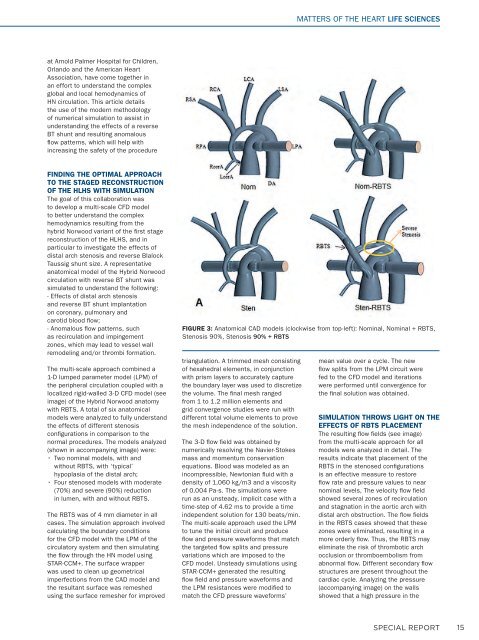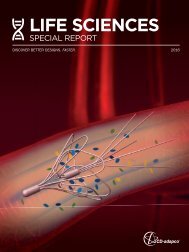Life science special report 161215 IY opt
You also want an ePaper? Increase the reach of your titles
YUMPU automatically turns print PDFs into web optimized ePapers that Google loves.
MATTERS OF THE HEART LIFE SCIENCES<br />
at Arnold Palmer Hospital for Children,<br />
Orlando and the American Heart<br />
Association, have come together in<br />
an effort to understand the complex<br />
global and local hemodynamics of<br />
HN circulation. This article details<br />
the use of the modern methodology<br />
of numerical simulation to assist in<br />
understanding the effects of a reverse<br />
BT shunt and resulting anomalous<br />
fl ow patterns, which will help with<br />
increasing the safety of the procedure<br />
FINDING THE OPTIMAL APPROACH<br />
TO THE STAGED RECONSTRUCTION<br />
OF THE HLHS WITH SIMULATION<br />
The goal of this collaboration was<br />
to develop a multi-scale CFD model<br />
to better understand the complex<br />
hemodynamics resulting from the<br />
hybrid Norwood variant of the fi rst stage<br />
reconstruction of the HLHS, and in<br />
particular to investigate the effects of<br />
distal arch stenosis and reverse Blalock<br />
Taussig shunt size. A representative<br />
anatomical model of the Hybrid Norwood<br />
circulation with reverse BT shunt was<br />
simulated to understand the following:<br />
- Effects of distal arch stenosis<br />
and reverse BT shunt implantation<br />
on coronary, pulmonary and<br />
carotid blood fl ow;<br />
- Anomalous fl ow patterns, such<br />
as recirculation and impingement<br />
zones, which may lead to vessel wall<br />
remodeling and/or thrombi formation.<br />
The multi-scale approach combined a<br />
1-D lumped parameter model (LPM) of<br />
the peripheral circulation coupled with a<br />
localized rigid-walled 3-D CFD model (see<br />
image) of the Hybrid Norwood anatomy<br />
with RBTS. A total of six anatomical<br />
models were analyzed to fully understand<br />
the effects of different stenosis<br />
confi gurations in comparison to the<br />
normal procedures. The models analyzed<br />
(shown in accompanying image) were:<br />
• Two nominal models, with and<br />
without RBTS, with ‘typical’<br />
hypoplasia of the distal arch;<br />
• Four stenosed models with moderate<br />
(70%) and severe (90%) reduction<br />
in lumen, with and without RBTS.<br />
The RBTS was of 4 mm diameter in all<br />
cases. The simulation approach involved<br />
calculating the boundary conditions<br />
for the CFD model with the LPM of the<br />
circulatory system and then simulating<br />
the fl ow through the HN model using<br />
STAR-CCM+. The surface wrapper<br />
was used to clean up geometrical<br />
imperfections from the CAD model and<br />
the resultant surface was remeshed<br />
using the surface remesher for improved<br />
FIGURE 3: Anatomical CAD models (clockwise from top-left): Nominal, Nominal + RBTS,<br />
Stenosis 90%, Stenosis 90% + RBTS<br />
triangulation. A trimmed mesh consisting<br />
of hexahedral elements, in conjunction<br />
with prism layers to accurately capture<br />
the boundary layer was used to discretize<br />
the volume. The fi nal mesh ranged<br />
from 1 to 1.2 million elements and<br />
grid convergence studies were run with<br />
different total volume elements to prove<br />
the mesh independence of the solution.<br />
The 3-D fl ow fi eld was obtained by<br />
numerically resolving the Navier-Stokes<br />
mass and momentum conservation<br />
equations. Blood was modeled as an<br />
incompressible, Newtonian fl uid with a<br />
density of 1,060 kg/m3 and a viscosity<br />
of 0.004 Pa-s. The simulations were<br />
run as an unsteady, implicit case with a<br />
time-step of 4.62 ms to provide a time<br />
independent solution for 130 beats/min.<br />
The multi-scale approach used the LPM<br />
to tune the initial circuit and produce<br />
fl ow and pressure waveforms that match<br />
the targeted fl ow splits and pressure<br />
variations which are imposed to the<br />
CFD model. Unsteady simulations using<br />
STAR-CCM+ generated the resulting<br />
fl ow fi eld and pressure waveforms and<br />
the LPM resistances were modifi ed to<br />
match the CFD pressure waveforms’<br />
mean value over a cycle. The new<br />
fl ow splits from the LPM circuit were<br />
fed to the CFD model and iterations<br />
were performed until convergence for<br />
the fi nal solution was obtained.<br />
SIMULATION THROWS LIGHT ON THE<br />
EFFECTS OF RBTS PLACEMENT<br />
The resulting fl ow fi elds (see image)<br />
from the multi-scale approach for all<br />
models were analyzed in detail. The<br />
results indicate that placement of the<br />
RBTS in the stenosed confi gurations<br />
is an effective measure to restore<br />
fl ow rate and pressure values to near<br />
nominal levels, The velocity fl ow fi eld<br />
showed several zones of recirculation<br />
and stagnation in the aortic arch with<br />
distal arch obstruction. The fl ow fi elds<br />
in the RBTS cases showed that these<br />
zones were eliminated, resulting in a<br />
more orderly fl ow. Thus, the RBTS may<br />
eliminate the risk of thrombotic arch<br />
occlusion or thromboembolism from<br />
abnormal fl ow. Different secondary fl ow<br />
structures are present throughout the<br />
cardiac cycle. Analyzing the pressure<br />
(accompanying image) on the walls<br />
showed that a high pressure in the<br />
SPECIAL REPORT<br />
15



